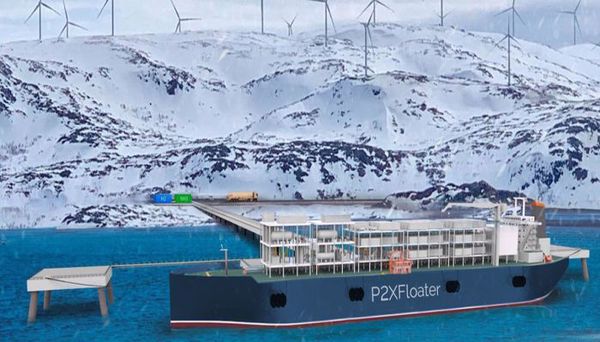EXCLUSIVE: H2Carrier chief executive on pioneering a floating green marine fuels facility
H2Carrier chief executive Mårten Lunde explains how green ammonia can be produced cost-effectively on floating units and compete with grey ammonia and other energy forms in an interview with Engine.

PHOTO: Aerial view of H2Carrier's P2XFloater. H2Carrier
Norway-based H2Carrier has developed what could become the world’s first large-scale floating green hydrogen and ammonia facility. A concept design of the facility was recently approved by classification society DNV.
The facility is actually a very large gas carrier (VLGC) converted to a floating production, storage and offloading unit (FPSO) with a scalable production capacity of 100,000-230,000 mt/year.
The FPSO will produce green ammonia from hydrogen and nitrogen through the well-matured Haber-Bosch process. Green hydrogen will be produced through electrolysis of desalinated seawater with renewable energy. Nitrogen will be captured directly from the air and synthesised in an ammonia generator onboard.
“We expect to export the majority of the production, while bunkering options will be made available once demand picks up from the maritime sector," Lunde says.
His company plans to “build, own, and operate” a fleet of the FPSOs, which are called P2XFloater. It is currently working on projects in the UK and Norway, but will eventually seek to expand to new markets worldwide.
Given the highly corrosive nature of ammonia, it will be stored using ammonia-compliant low-carbon steel on the FPSO, says Lunde. Safety guidelines and risk assessments are already in place, and crew and workers will be trained to handle ammonia.
As for the cost-effectiveness of green ammonia produced by these facilities compared to conventional fuels, Lunde explained that green ammonia's cost will depend on the electricity price as well ammonia production capacity utilisation. But costs are currently projected to be substantially lower for green than grey ammonia due to “exceptionally high gas prices”.
While green hydrogen and ammonia production is forecast to rise rapidly as the world transitions to renewable energy over the coming decades, about 95% of the hydrogen produced in the world today is so-called "grey", according to estimates by the US Department of Energy. This means it is produced from steam methane reforming of carbon-containing natural gas.
As a next step, H2Carrier announced this month it will conduct a study on the FPSO with Norwegian engineering firm KANFA and with Statkraft, Europe’s largest renewable energy generator. They will study challenges related to offshore electrolysers operation and ammonia production with variable load handling.
By Konica Bhatt
Please get in touch with comments or additional info to news@engine.online





